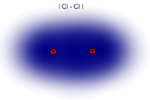Polar atomic bond
Polar atomic bonds are chemical bonds in which the atoms involved carry partial charges due to their different electronegativity . However, the difference is not great enough that a pure ionic bond is created.
The atom with the larger electronegativity (EN) attracts the binding electrons more strongly than the atom with the smaller electronegativity. This makes the charge distribution along the atomic bond asymmetrical. The atom of the stronger electronegative element receives a negative partial charge, the atom of the weaker electronegative element receives a positive partial charge. These partial charges are smaller than the charges of ions . The polar atomic bond represents a transition from the pure atomic bond to the ionic bond.
In principle, any pairing between atoms that are different elements is polar. However, the polarity of the bond can vary. The frequently cited rule of thumb that up to a certain electronegativity difference ( Delta-EN ) of about 0.4 there is a covalent bond and from about 1.7 an ionic bond should be understood to mean that it makes sense in these cases, to describe the bond more covalently or more ionically . The EN difference is not the only criterion. The size and ratio of the atoms involved, as well as the coordination numbers, can also play a major role.
For example, hydrogen fluoride is a polar covalently bound molecule despite the large EN difference of 1.8. The compound is a gas at room temperature. In contrast, lithium hydride (LiH) and magnesium hydride (MgH 2 ) are salt-like compounds that can be described ionically, despite the significantly lower EN differences of approx. 1.2 and 0.8 respectively. LiH has z. B. the same structure as table salt (NaCl). In addition, molecules with a low polar bond can also dissolve in water (or other solvents ) to form ions . A very illustrative example is hydrogen iodide (HI). There is an EN difference of approximately zero here. Nevertheless, the molecule is slightly polar (H δ + -I δ− ) and a very strong acid (stronger than HCl). It forms H 3 O + and I - ions with water .
In bromomethane and other haloalkanes, the halogen atom is negatively (δ–) polarized, the carbon atom opposite is polarized positively (δ +) (see figure).
It is a little different with the molecular structure . It can happen that a molecule with polar atomic bonds does not have a dipole moment to the outside . This always occurs when, due to the symmetrical structure of the molecule, the positive and negative centers of charge are identical. This is the case, for example, with molecules such as carbon dioxide (CO 2 ) or carbon tetrafluoride (CF 4 ). Here the delta-EN is 1.0 or 1.5. Because the molecules are linear or tetrahedral, the centers of charge coincide in both cases and both have no dipole moment. This can be seen, for example, from the relatively low boiling points. The intermolecular attraction here is based only on Van der Waals forces .
Non-polar atomic bonds only come about when two atoms of absolutely equal electronegativity connect with each other. This is only the case with bonds between atoms of the same chemical element . In the case of very small EN differences - as in the case of the CH combination - only a very weak bond polarity is found. Most hydrocarbon molecules accordingly have very small partial charges. Their boiling points are therefore relatively low compared to other molecules of similar size, since the forces of the hydrogen bonds are correspondingly low due to the low polarity .
Individual evidence
- ↑ Brockhaus ABC Chemie , VEB FA Brockhaus-Verlag Leipzig 1965, pp. 304-305.
- ^ Hans Beyer and Wolfgang Walter : Organische Chemie , S. Hirzel Verlag, Stuttgart, 1984, pp. 29–31, ISBN 3-7776-0406-2 .


